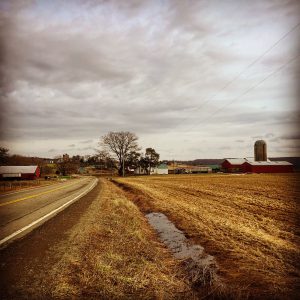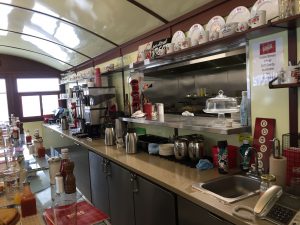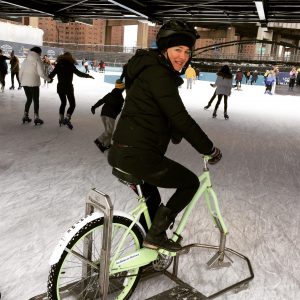Published in Forever Young January 2019

“This land is your land” is booming on the car stereo as we cross the Peace Bridge. The sun is sparkling off Lake Erie on our right, the sky grey, the trees naked, and sadly green grass with only patches of snow.
What was originally conceived of us a family weekend of cross-country skiing in New York State quickly morphed into an entirely different sort of trip as the warm weather blew in, and rain replaced snow.
The City of Lights
Stop one was Buffalo, a city once known as the City of Light (for its early adaptation of electrical power) and for its steel and grain production. More recently, it was a destination for cross-border shopping when the Canadian dollar was stronger. Now it is so much more. Making its way into the highly acclaimed New York Times top 52 places to visit, Buffalo now has a booming downtown core: there’s trendy Elmwood Village with cool restaurants and shops, up-and-coming Hertel Avenue, contemporary art at the Albright-Knox Art Gallery, Frank Lloyd Wright architecture, and of course craft beer and traditional foods like beef on weck and Buffalo wings.
There’s also the blending of old and new.
Hotel Henry

One of the best examples of recent acquisitions is the Hotel Henry, billed as an “urban resort conference center” on the Richardson Olmsted Campus, so named for design contributions of famed architect Henry Hobson Richardson, and the Olmsted and Vaux team, who co-designed Central Park. The original 1880 building was formerly the Buffalo State Asylum for the Insane, which was renowned for incorporating what was then progressive principles around psychiatric treatment: it was brightly lit, and built on 200 acres where patients could farm.
The campus is now a national historic landmark, and extends over 42 acres, with an architecture centre to open there in November. Arriving there involves driving through a campus of red brick buildings to the impressive Medina sandstone building, with green copper roof that is the Hotel Henry.
“Do other people get lost?” I ask the doorman as we arrive, having entered on Forrest St. at the back vs. front of the campus.
“All the time,” he says without hesitation.
Once inside, we continue to get lost along its cavernous circular hallways that divide west and east wings——past small alcoves and lounges through what feels more like a contemporary art gallery than a hotel. Really, getting lost has never been quite such a pleasure.
Our room is small but compact with high ceilings and white walls that give it a feeling of light and space. From there we then forge out into the city.
Colored Musicians Club Museum
Our first stop is the Colored Musicians Club Museum, a one-room interactive museum documenting a long and impressive history of black jazz. Prevented from joining the all-white Buffalo musicians’ union, African American musicians created their own union in 1917, and then a social club the following year: they opened up in the current building in 1935.
“That was a big deal,” says its president George Scott, referencing black musicians having their own place to play music, and the ability to unionize. It was during the time of segregation, and “top musicians would come to town to play, but they couldn’t sit around and drink or talk to the audience after.” Instead, they would congregate here. With the union, they could get death benefits, be part of a credit union, “and for the first time, they could buy a car, [and] get a home… They were realizing the American dream.”
Above the museum is the club—the only remaining African American club of its kind in the United States. “This is where the magic happens,” says Scott, who plays saxophone here as part of the George Scott Big Band, and where you can come to hear other jazz or join a Sunday jam session.
Family-friendly meals

While in Buffalo, we also had many great family-friendly meals. For breakfast, the highlight was the Swan Street Diner, a 1937 Sterling Company diner car that first operated in Newark, NY before being transported to Akron, OH and now Buffalo. The diner still retains the original mahogany trim, barrel vaulted ceiling, and porcelain enamel on the walls and ceiling. And as well as breakfast and lunch, they offer a mean happy house—two freshly baked mini-donuts for a dollar.
For lunch, the Lloyd Taco Factory on Hertel Avenue is another good casual option. (With young kids, the place starts booming as the day progresses, so mid-day dining may be your best option.)
For dinner, my husband and I liked the craft beer and our kids the award-winning burgers at Cole’s Restaurant and Bar, a classic pub on Elmwood Avenue.
In between meals, we headed Canalside. Like a mini Rideau Canal, the rink is on the original site of a segment of the Erie Canal, and open for skating and ice biking in winter. With ice biking, you don’t have to worry about slipping and falling on the hard stuff: the bikes are encased in a stainless steel frame so even little kids are safe.

Chatauqua Institution
Exploring New York State beyond urban living, we then headed to Chatauqua County, with our first stop at the Chatauqua Institution, the legendary site for arts, culture, learning, religion and recreation.
We had a horse ‘n wagon tour of the property, where we learnt about the history of the Institution, which was and continues to be a summer camp for both adults and youth.
The Institution originated as a training camp for Sunday school teachers in 1874 and soon evolved into a summer lakeside community that purportedly had the first Boys and Girls’ Club in the United States, and a renowned morning lecture series on its ampitheatre stage. Among its distinguished speakers was Franklin D. Roosevelt, delivering his “I Hate War” speech. The site was also—and continues to be—a destination to see entertainers, play golf, go to a concert, attend an arts class or lecture, and commune with neighbours.
And while activities are bountiful, the lifestyle can also be leisurely, as captured by the sign on one porch that reads, “Take a nap. Feel the breeze. Read a book. Converse. Listen to music.”
Peek ‘n Peak
After Chatauqua, we headed to Peek ‘n Peak ski resort in Clymer, which is the main Western New York ski resort destination alternative to Holiday Valley in Ellicottville.
At Peek ‘n Peak there are 27 slopes and trails of downhill skiing, more than nine kilometres of cross-country ski trails, and tubing: although it was pouring rain while we were there, my husband and I went for a hike, the kids had a downhill ski lesson and we had an amazing mist-shrouded family tubing experience: seven lanes to ourselves, we raced each other down the hills, then headed back up on a magic carpet, and then repeat. I lost count by the 12th run.
While we were there, we ate at several nearby restaurants, which gave us a taste of the area. The Dutch Village Restaurant in the town of Clymer is a classic small-town restaurant with wholesome sandwiches on homemade bread, delicious pies and a gift shop next door. The French Creek Tavern about a five-minute drive away is a fun roadside dive with shuffleboard, fish sandwiches, homemade pizza and wings, and a pool table in back. And our favourite, reserved for our last night, was the—the Pine Junction Tavern, a rustic building open nightly until midnight with craft beer, a long wooden bar, a cozy vibe and an outdoor firepit.
IF YOU GO
If staying at the Hotel Henry between May and October, consider taking an historical tour of the Richardson Olmsted campus.
If visiting the Chatauqua Institution, note that there is a gate fee to stay there, on top of the cost of accommodations and special events. Check their website for more details at http://chq.org/plan-your-visit